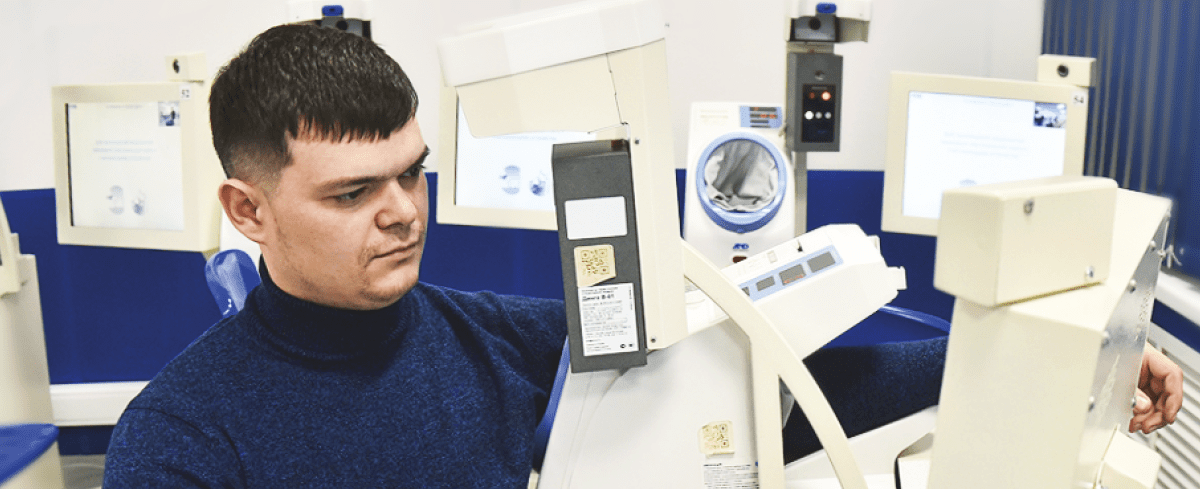Prevention of occupational diseases
In order to study and reduce the potential impact of workplace factors and prevent occupational diseases, Nornickel regularly monitors employee health.
Employees undergo compulsory pre‑employment medical examinations, followed by scheduled, regular, and ad hoc medical check‑ups. Those working in hazardous conditions are subject to periodic medical examinations at certified healthcare institutions authorised to conduct pre‑employment and periodic check‑ups, assess fitness for duty, and determine whether a disease is work‑related, within the timeframes established by law.
Before each shift or trip, employees are examined on site through pre‑shift and pre‑trip check‑ups.
The Company provides employees working in hazardous conditions with preventive nutrition, milk, or other equivalent food products in line with applicable legislation and Nornickel’s internal regulations.
Corporate Healthcare
People are Nornickel’s most valuable asset – its key capital and resource. The physical and mental well‑being of employees directly affects productivity and the Company’s overall performance. Ensuring accessible, timely, and high‑quality medical care – both through medical centres and onsite medical aid posts at industrial facilities – is a strategic priority for Nornickel. This commitment is reflected in the Company’s 2030 Socially Sustainable Development Strategy.
For the past five years, Nornickel has been implementing a corporate healthcare development project. It includes the construction and upgrade of medical infrastructure, recruitment of highly qualified medical professionals, adoption of advanced information technologies, and support for public healthcare in the Company’s regions of operation.
In cities where Nornickel employees and their families live, the Company has established a process for conducting comprehensive assessments of local healthcare systems and their specific components. These analytical efforts provide a deep insight into the operations of healthcare institutions, helping to identify strengths, pinpoint areas for improvement, and adapt strategies to enhance the quality of medical services.
At the same time, information campaigns are underway to promote healthy lifestyles, alongside dedicated health programmesHealthy Woman of the North (Monchegorsk), Healthy Heart, and Diabetes School (Norilsk, Dudinka).. Advanced solutions are being introduced to give employees across all regions access to expert, timely information on effective ways to take care of their health, contributing to improved well‑being and quality of life.
Corporate Healthcare in figures
Medical centres
Central outpatient facility in Norilsk
(established in 2021)
- 14 primary healthcare areas
- 237 types of medical services
- 300.5 thousand medical services provided (since launch)
Dudinka Medical Centre (DMC)
(established in 2023)
- 11 primary healthcare areas
- 236 types of medical services
- 17.1 thousand medical services provided (since launch)
MRI centre in Monchegorsk
(established in 2023)
- 6 diagnostic and consultation areas
- 106 types of medical services
- 1.8 thousand MRI scans performed (since launch)
Medical centre in the Talnakh District of Norilsk
- A medical centre in Talnakh was commissioned in December 2024
Disease prevention centre in Monchegorsk
(scheduled for commissioning in 2027)
Medical centre in the Kayerkan District of Norilsk
(scheduled for commissioning in 2025, with planned medical licensing)
Medical centre in the Central District of Norilsk
(scheduled for commissioning in 2030)
Medical aid posts and health check rooms
The Company has established the primary level of its corporate healthcare system – a shop‑floor medical service staffed by a general practitioner, present on a regular basis. The service is designed to deliver quality medical care to employees directly on the shop floor.
Medical centres

An information system and a mobile app for employees were developed and launched, enabling employees to instantly access their medical records, book doctor appointments, and receive up‑to‑date information about clinic services. In addition, a disease risk assessment and electronic medical record management system was implemented.